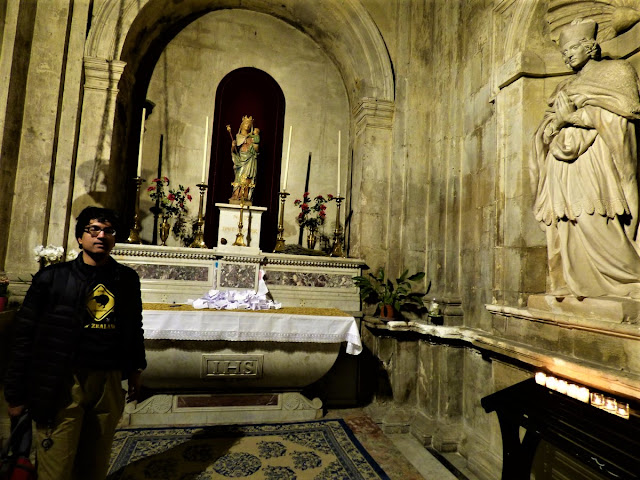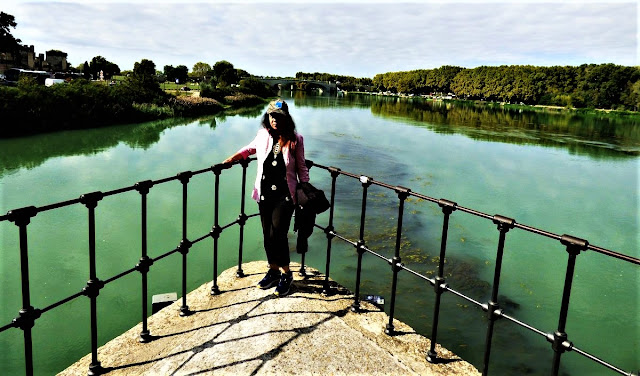DAY 7, SEPTEMBER 22, 2022
STAY
Antibes 4 nights, Lagrange ApartHôtel Antibes Olympie
SIGHTS
Avignon old town, Palace of Popes [Palais des Papes], Church, Pont Saint Bénézet bridge, Drive to Antibes
CHECKED OUT
Son went off to bring the car to the apt gate from the night parking spot. He did not repeat the previous day's mistake and drove along the perimeter of the wall and entered our empty street. I was ready at the gate with our bags. In a couple of minutes we were off... no hassle re the one way. Another guy had also come in like us.
We went to the square with the Pope's palace and parked in the underground ticketed parking.
The palace and the church look so impressive We had to wait for the palace to open. We visited the church.
Basilique Métropolitaine Notre-Dame des Doms
Then we tried to visit the bridge but that was not open as well. We walked back to the palace square.the Place du Palais
Place du Palais/ Palace square
We walked along the rampart and enjoyed shops setting up their lavender products.
Palais de Papes
Bought the combo ticket for palace, garden and bridge and entered the pa;ace when it opened
The UNESCO-listed Palais de Papes was the residence of seven Popes from 1309 to 1377 and is a testimony to the wealth and power of Christendom during the Middle Ages
Designated as a UNESCO World Heritage Site, this imposing palace was the most important monument in Christendom during the 14th century, when Pope Clement V moved the papal court from Rome to Avignon.
Highlights include the Great Audience Hall, an enormous hall embellished with wall paintings.
Nice model here
 The palace visit also takes us into the private apartments where the pope lived, including the Papal Chamber and the Stag Room, decorated with frescoes on a naturalistic, secular theme that was totally unique for the time.
The palace visit also takes us into the private apartments where the pope lived, including the Papal Chamber and the Stag Room, decorated with frescoes on a naturalistic, secular theme that was totally unique for the time. POPE'S BEDROOM
This is one of the few rooms in the palace where original and relatively well preserved wall paintings can be seen. The Pope slept in this room with servants called cubiculars (def: eunuch chamberlains) who looked after him. The furniture consisted of a bed – I suppose that the cubiculars slept on the floor – silk curtains, a chair, a table, a stool and several chests containing linen lined against the walls. Some popes also kept caged birds in their room as most were fond of birds.
The artwork on the wall is interesting. It looks almost like wallpaper, the mural is thought to have been painted in the mid-1300's – way before wallpaper was invented in the 18th century! The main motif represents yellow vines with green and reddish leaves or flowers against a deep blue background. The literature says that the design is populated with animals, but I can't see any animals in this picture. The paintings were originally done in tempera but have been extensively restored in the 1930's.
;the Saint Martial and Saint John chapels, decorated with well-preserved frescoes created by the Italian painter Matteo Giovanetti; and the Great Clementine Chapel, a huge single-aisled church where official ceremonies were held.
From the Great Chapel, there is an entrance to the loggia where the large traceried Fenêtre de l'Indulgence (Window of Indulgence) offers a view of the Great Courtyard. From this window, the Pope used to give his blessings to the faithful.
NORTH SACRISTY
GARDEN
The garden has great views of the palace buildingLAVENDER BUSH
we walked to the bridge next through the old town
Pont Saint Bénézet/Pont d'Avignon
This graceful 13th-century landmark is one of Avignon's most iconic sites
The Saint Bénézet Bridge is intriguing for its romantic half-ruined state and legendary association. Many are familiar with the famous song about the bridge ("Sur le Pont d'Avignon"), which was originally composed in the 16th century.
During the Middle Ages, the Pont Saint Bénézet was an essential crossing on pilgrimage routes between Spain and Italy. The bridge was used for transportation across the Rhône River until the 17th century (when the structure collapsed).
The Pont Saint Bénézet is listed as a UNESCO World Heritage Site and is open to the public as a museum. The site features multimedia displays that show how the bridge and its setting evolved over the centuries. we can also admire the 13th-century Chapel of Saint Nicolas, which is part of the bridge.
we walked up to the ramparts but the door from here was locked
rampart tower...
we walked back to our parking and drove off toward Antibes






































































No comments:
Post a Comment